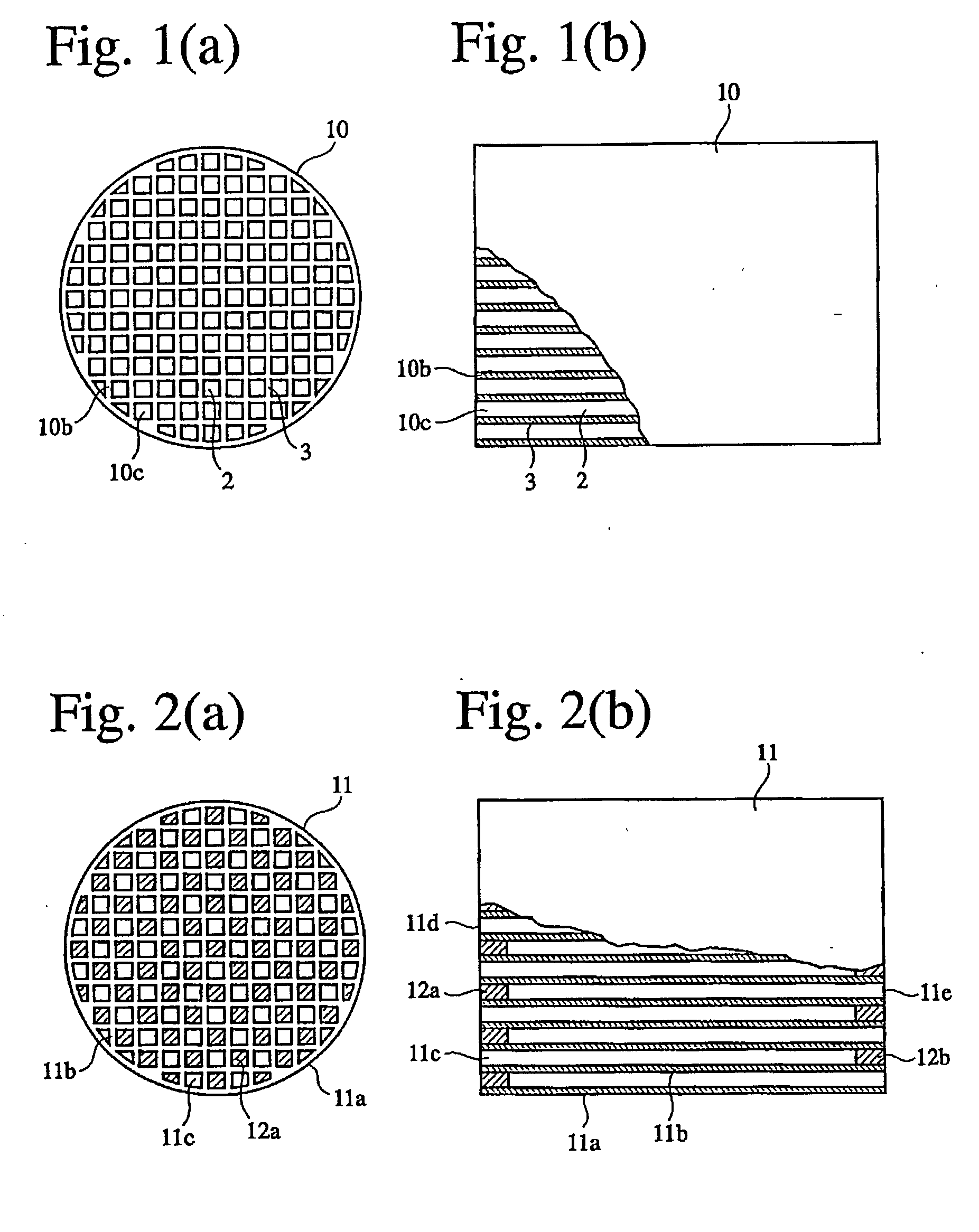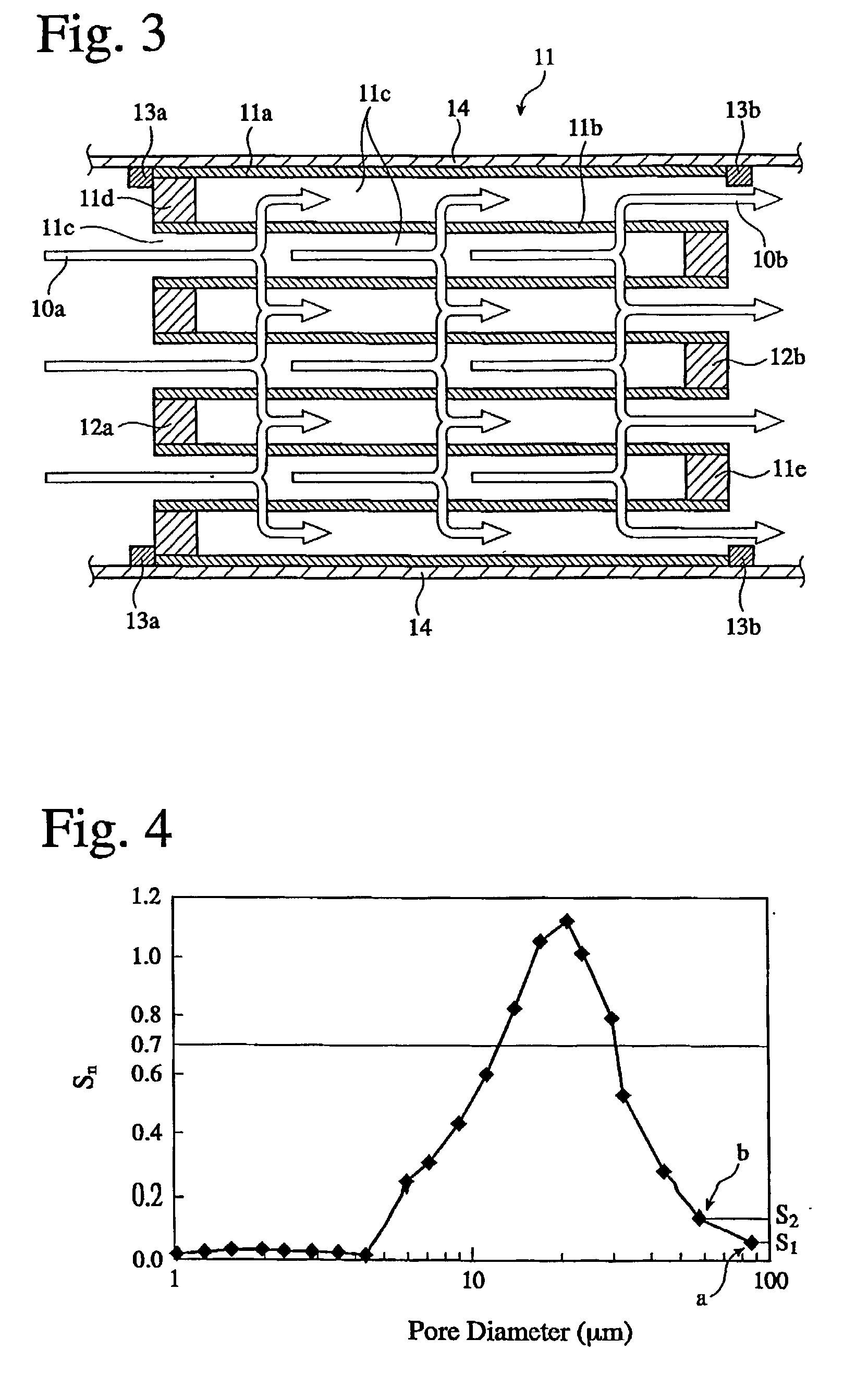Ceramic honeycomb filter
a honeycomb filter and honeycomb technology, applied in the field of honeycomb filter, can solve the problems of reducing the efficiency of capturing, increasing the pressure loss, and reducing the engine outpu
- Summary
- Abstract
- Description
- Claims
- Application Information
AI Technical Summary
Benefits of technology
Problems solved by technology
Method used
Image
Examples
reference example 1
1 AND 2, REFERENCE EXAMPLE 1
[0087] To form cordierite having a main component composition comprising 49-51% by mass of SiO.sub.2, 35-37% by mass of Al.sub.2O.sub.3 and 13-15% by mass of MgO, kaolin powder, calcined kaolin powder, alumina powder, aluminum hydroxide powder, silica powder and talc powder were mixed together with a binder, a lubricant and spherical resin powder as a pore-forming material in predetermined amounts. The resultant mixture was mixed with water to form a plasticizable batch. This batch was extrusion-molded to a cylindrical honeycomb shape, and dried.
[0088] The particle diameter distribution of the spherical resin powder used as the pore-forming material is shown in FIG. 16. The average particle diameter and the percentage of particle diameter in 20-100 .mu.m of the spherical resin powder are shown in Table below.
2 Pore- Average Percentage of Particle Forming Particle Diameter in 20-100 Material Diameter (.mu.m) .mu.m (% by mass) Example 1 64 75 Example 2 62 6...
examples 3-7
[0108] The same plasticizable batch as in Example 1 was produced, and this batch was molded to a cylindrical honeycomb structure by an extrusion-molding method. The size of a molding die was adjusted to provide various partition wall thickness and various numbers of flow pats per 1 cm.sup.2. Each green body was sintered at a temperature of 1350-1440.degree. C., to obtain cordierite honeycomb structures of Examples 3-7 each having porous partition walls and penetrating pores for flow paths. Each honeycomb structure had a diameter of 143 mm and a length of 152 nm with partition wall thickness of 0.15-0.33 mm, the number of flow paths per 1 cm.sup.2 being 39-62. Also, each honeycomb structure had a porosity of 65% and an average pore diameter of 20.8%, the maximum of the slope S.sub.n of its cumulative pore volume curve being 1.12.
[0109] Both ends of each filter were sealed in the same manner as in Example 1 to produce a cordierite honeycomb filter. The pressure loss and fracture resis...
examples 8 and 9
, REFERENCE EXAMPLE 2
[0110] As a ceramic material with a high specific surface area, activated alumina powder having a center particle size of 5 .mu.m and alumina sol were mixed with water to form an activated alumina slurry. This slurry was wash-coated onto the same ceramic honeycomb structures as in Examples 1 and 2 and Reference Example 1. After removing an excess slurry, the coating of a slurry was repeated, and a 60 g / L of activated alumina was finally coated onto the honeycomb structure. After the honeycomb structure was dried at 120.degree. C., it was sintered at 800.degree. C. Further, each honeycomb structure was immersed in an aqueous chloroplatinic acid solution, dried at 120.degree. C., and then sintered at 800.degree. C. Ceramic honeycomb filters each carrying about 2 g / L of a platinum catalyst were thus obtained.
[0111] The ceramic honeycomb filter carrying a platinum catalyst was measured with respect to pressure loss in the same manner as in Example 1. The pressure lo...
PUM
| Property | Measurement | Unit |
|---|---|---|
| Length | aaaaa | aaaaa |
| Length | aaaaa | aaaaa |
| Fraction | aaaaa | aaaaa |
Abstract
Description
Claims
Application Information
 Login to View More
Login to View More - R&D
- Intellectual Property
- Life Sciences
- Materials
- Tech Scout
- Unparalleled Data Quality
- Higher Quality Content
- 60% Fewer Hallucinations
Browse by: Latest US Patents, China's latest patents, Technical Efficacy Thesaurus, Application Domain, Technology Topic, Popular Technical Reports.
© 2025 PatSnap. All rights reserved.Legal|Privacy policy|Modern Slavery Act Transparency Statement|Sitemap|About US| Contact US: help@patsnap.com



